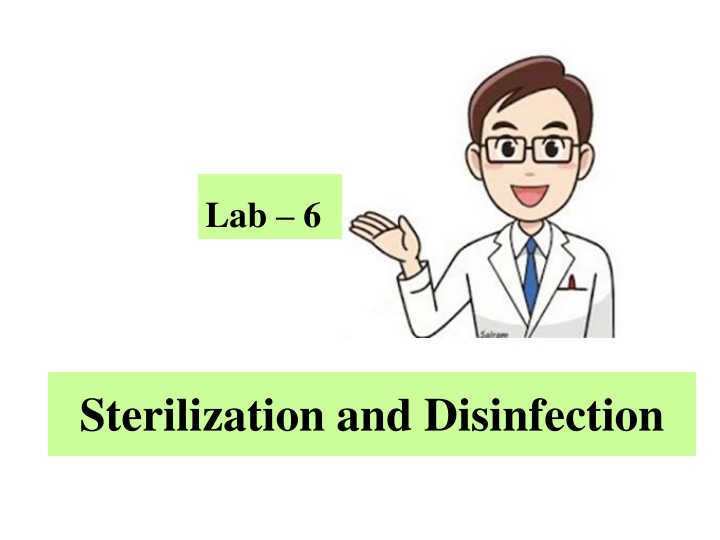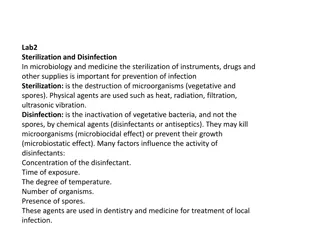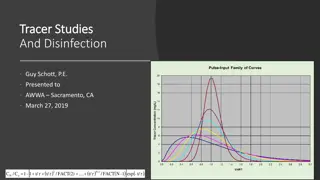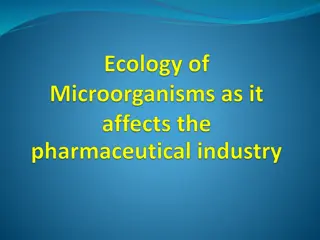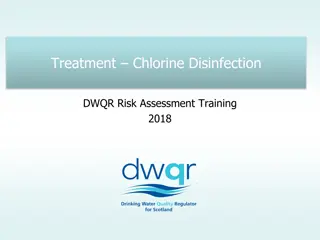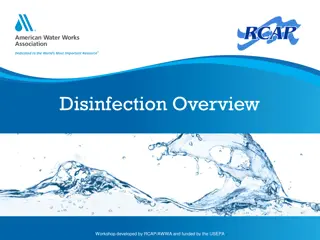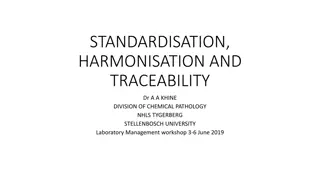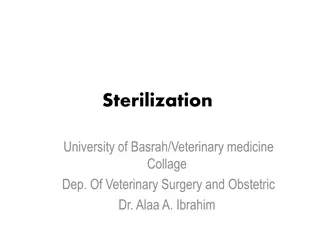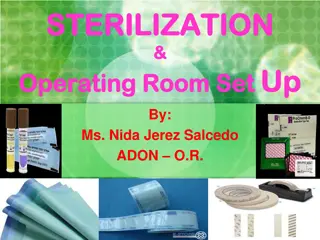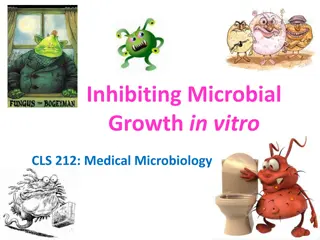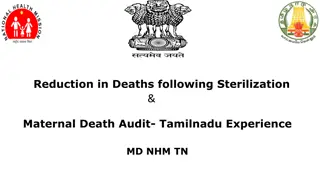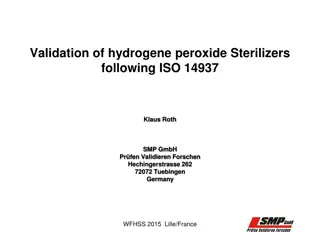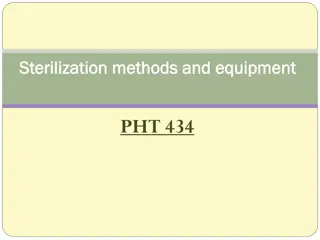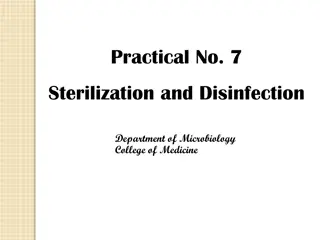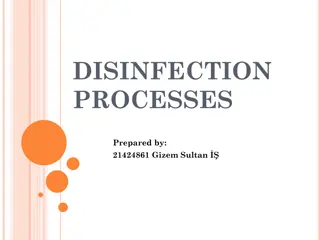Sterilization and Disinfection Methods in Laboratory Settings
Sterilization involves killing all microorganisms while disinfection targets pathogenic ones. Various methods like heat, filtration, radiation, and chemicals are used for effective sterilization. Physical sterilization through heat includes dry heat, direct flaming, hot air ovens, and incineration. Understanding these techniques is crucial for maintaining a sterile environment in laboratories.
Download Presentation

Please find below an Image/Link to download the presentation.
The content on the website is provided AS IS for your information and personal use only. It may not be sold, licensed, or shared on other websites without obtaining consent from the author.If you encounter any issues during the download, it is possible that the publisher has removed the file from their server.
You are allowed to download the files provided on this website for personal or commercial use, subject to the condition that they are used lawfully. All files are the property of their respective owners.
The content on the website is provided AS IS for your information and personal use only. It may not be sold, licensed, or shared on other websites without obtaining consent from the author.
E N D
Presentation Transcript
Lab 6 Sterilization and Disinfection
Sterilization:is the killing or removal of all microorganisms, including bacterial spores, which are highly resistant. e.g.: - Sterilization by autoclave (121oC , 15Klb). - Ethyl oxide gas for surgical instruments. - Filtration for intravenous solution. Disinfection:is the killing of most, but not all microorganisms, mainly the pathogenic ones. For adequate disinfection, pathogens must be killed but some organisms and bacterial spores may survive. - Disinfectants vary in their tissue-damaging from the phenol, which should be used only on inanimate objects, to less toxic materials such as ethanol and iodine which can be used on skin surface. - Chemicals used to kill microorganisms on the surface of skin and mucous membrane are called antiseptics.
Classification of Sterilization Methods Chemical Sterilization Physical Sterilization Heat Filtration Radiation Direct Sun Light Non Ionizing Radiation Ionizing Radiation Infrared Radiation Moist Heat Dry Heat Flaming (Red heat) Hot air oven Incineration Sterilization at a temp. below 100Co Sterilization at 100Co Sterilization at temp. above 100Co
Classification of sterilizing agents: 1-physical agents: A. heat B. Filtration C. Radiation. 2- Chemical agents.
Physical sterilization 1. Heat: Most effective, cause stope cellular activates by coagulate proteins or oxidize cell components. A. Dry Heat 1. Direct flame: the simplest method is direct flaming. Used for rapid and repeated sterilization. This Type of sterilization is used for metal instruments such as platinum wire loop, forceps and scissors etc. Bunsen burner is commonly used for sterilization by dry heat (direct flame). 2. Hot air: All glassware and metal instrument are usually sterilized by this method. Generally, the instruments are left in a Hot Air Oven on a temperature of 160-180 for one hour. 3. Incineration: The use of electrically heated or gas-fired incineration filled with forced air blower units, provide an excellent means of rapidly destroying articles such as solid dressings, pathological material, animal caresses and bedding.
FLAMING A simple & effective method. Loops or wires, needle. Instruments held on a Bunsen flame till red-hot.
Hot air oven Glassware Glassware
B-moist heat 1.pasteurization: uses heat 63 at 30 minutes. The organisms such as Brucella or Salmonella and tubercle bacilli which contribute to milk born-disease are readily killed by this process. N.T: bacterial spores are not killed by this method. 2.Boiling water:A temperature at 100 will kill all non-sporing and vegetative organisms within 10 minutes. Most spores will be killed in 30 minutes at this temperature, but some spores will resist boiling for several hours. The addition of 2% sodium carbonate increases the disinfecting power of the water, and spores resistant to boiling water for 10 hours have been killed in 30 minutes by this addition. This method is suitable for infected instruments or small pieces of infected glassware.
3. Tyndallization:the process of sterilization by intermittent steaming., is a form of sterilization that involves boiling the goods to be sterilized in their cans or jars at 100 for about 15 to 20 minutes a day, for three days in a row. Sterilized canned food. 4.Steam under pressure (high pressure steam): The autoclave or pressure cooker is the instruments used for high pressure steam sterilization. Bacteriological media, surgical instruments are sterilized in the autoclave at 121 (15 Ibs) for 15 minutes. Autoclave
MOIST HEAT Sterilization By Moist heat Moist heat At 100 C Moist heat At above 100 C Moist heat at Below 100 C Boiling Tyndallization Autoclave e.g.. pasteurization
2. Filtration:The principle of this method is to pass the material to be sterilized through special bacterial filters which hold back any bacteria present. This method is used for the sterilization of fluids that do not withstand heating, e.g. Sera, Plasma, Vitamins and Antibiotic solutions. Several kinds of bacterial filters are available. The kinds which are most used are the chamborlain and Daulton filters which are made of unglazed porcelain, the Mandler Fillters , Seitz filters, etc.
3.Radiation: It is employed commercially for the sterilization of large amount of pre-packed disposable items such as plastic syringes and Catheters that are unable to withstand heat. It is done by applying ultra-violet rays. sterilized by ionizing radiation
Chemical sterilization. 1-Alcohols, Ethyl alcohol, Isopropyl alcohol (70% aqueous solution): Uses: Antiseptic to sterilize the thermometer, the skin before injection. 2-Phenols: Uses: sterilization of surgical instruments, bathroom, hospital floor. Chlorohexidin ; as skin disinfectants. 3-Heavy metal ions (Mercury, silver nitrate): Uses: Mercuric salt e.g Methiolate used as preservation for sera, bacterial and viral vaccine. Silver salt e.g AgNO3 (1%) used as eye drop for newborn infants to prevent infections by Neisseria gonorrhea.
4-Oxidizing agent. Uses: H2O2, for disinfection of contaminated wounds. 5- Halogens : chlorine and hypochlorite, iodine Uses: to disinfect the swimming pools and water supplies. 6-Akalyting agents a. Formaldehyde. used in the sterilization of instruments, lab, clothing, books. b -Ethylene oxide used to sterilize heat sensitive objective such as plastic petri dishes, tubes, syringes, pipettes. 7-Detergents: *Soaps to clean the skin. *quaternary Compounds used as antiseptic and disinfectant.
Iodine (Betadine): used in surgery to sterilize skin pre-operation
Experiment: Materials Provided: Tubes of nutrient broth Sterile, empty tubes Sterile, 1.0-ml pipettes (cotton plugged) Sterile, 1.0-ml pipettes (cotton plugged) 1.0 per cent phenol, 2.0 per cent phenol Absolute alcohol, 70 per cent alcohol 3.0 per cent hydrogen peroxide 1.0 per cent Lysol, 5 per cent Lysol Tincture of iodine Antiseptic mouthwash 24-hour nutrient broth culture of Escherichia coli Three-to-six-day-old culture of Bacillus subtilis
Procedures: 1- Select one of the chemical agents. Draw 5.0ml of the solution into a sterile test tube. 2- To the 5ml of disinfectant, add 0.5ml of the E. coli culture. Gently shake the tube to distribute the organisms uniformly. Note the time. 3- At intervals of 2, 5, and 10 minutes, transfer one loop full of the disinfectant- culture mixture to a tube of fresh nutrient broth. Label each broth tube with the name of the organism, the disinfectant, its concentration, and the time of exposure (for example, E. coli, 1 percent phenol, 2 minutes). 4- Using the same concentration of the same disinfectant, repeat procedures 1 to 3 with the culture of Bacillus subtilis.
5- Inoculate a tube of nutrient broth directly from the E. coli culture and another from the B. subtilis culture. Label each tube with the name of the organism and the word ''Control''. 6- Incubate all tubes at 35 for 48 hours. 7- Record your results.
